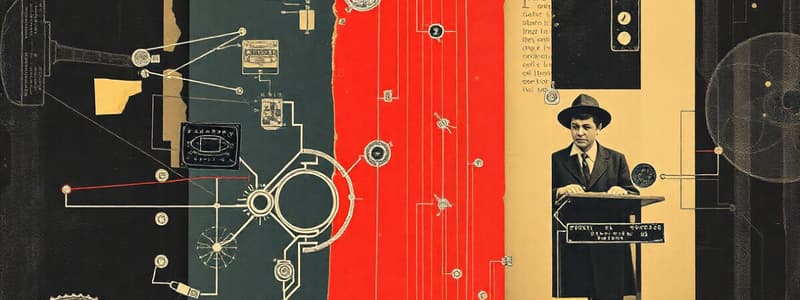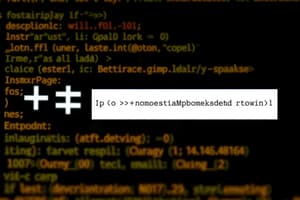Podcast
Questions and Answers
What does CRC stand for in the context of error detection?
What does CRC stand for in the context of error detection?
- Cyclic Repetition Check
- Cyclic Redundancy Check (correct)
- Cyclic Resilience Code
- Cyclic Redundancy Coding
Which statement best describes how a sender computes the CRC bits?
Which statement best describes how a sender computes the CRC bits?
- By adding the data bits to the generator bit pattern
- By ensuring the computed bits are divisible by the generator bit pattern (correct)
- By multiplying the data bits by 2 raised to the power of r
- By directly appending the generator bit pattern to the data bits
What kind of errors can the CRC method reliably detect?
What kind of errors can the CRC method reliably detect?
- Errors in even-numbered bits
- All bit errors in the data stream
- All single-bit errors
- Burst errors less than r+1 bits (correct)
In the formula $D.2^r \oplus R = nG$, what does $D$ represent?
In the formula $D.2^r \oplus R = nG$, what does $D$ represent?
Why is the CRC technique widely used in practice, such as in Ethernet?
Why is the CRC technique widely used in practice, such as in Ethernet?
What is the primary function of CSMA/CD in a network?
What is the primary function of CSMA/CD in a network?
Which factor is crucial in determining the probability of collisions in CSMA?
Which factor is crucial in determining the probability of collisions in CSMA?
What does a node do upon detecting a collision in the CSMA/CD protocol?
What does a node do upon detecting a collision in the CSMA/CD protocol?
Why might CSMA/CD be difficult to implement in wireless networks?
Why might CSMA/CD be difficult to implement in wireless networks?
What happens in the binary exponential backoff process after m collisions in CSMA/CD?
What happens in the binary exponential backoff process after m collisions in CSMA/CD?
How do channel partitioning MAC protocols perform at low network loads?
How do channel partitioning MAC protocols perform at low network loads?
In a situation with many active nodes, what is a significant drawback of random access MAC protocols like CSMA?
In a situation with many active nodes, what is a significant drawback of random access MAC protocols like CSMA?
What is the first step in the Ethernet CSMA/CD algorithm?
What is the first step in the Ethernet CSMA/CD algorithm?
What is the destination address in the frame transmission?
What is the destination address in the frame transmission?
Which protocol does device B use to pass the datagram up the protocol stack?
Which protocol does device B use to pass the datagram up the protocol stack?
What technology predominantly uses switched physical topology today?
What technology predominantly uses switched physical topology today?
What is the main advantage of Ethernet over other LAN technologies?
What is the main advantage of Ethernet over other LAN technologies?
In a bus topology, what occurs when all nodes are in the same collision domain?
In a bus topology, what occurs when all nodes are in the same collision domain?
What encapsulates the IP datagram in an Ethernet frame?
What encapsulates the IP datagram in an Ethernet frame?
What was one of the significant advancements in Ethernet technology reported?
What was one of the significant advancements in Ethernet technology reported?
Which component is central in the switched physical topology?
Which component is central in the switched physical topology?
What common feature is associated with LAN addressing?
What common feature is associated with LAN addressing?
Which protocol deals with error detection and correction in LANs?
Which protocol deals with error detection and correction in LANs?
What type of routing protocol is primarily used for inter-domain routing?
What type of routing protocol is primarily used for inter-domain routing?
What is the maximum pending link speed mentioned for the UMass campus network?
What is the maximum pending link speed mentioned for the UMass campus network?
Which of the following is an intra-domain routing protocol mentioned in the content?
Which of the following is an intra-domain routing protocol mentioned in the content?
Which type of switching is primarily used in the building closets for the network?
Which type of switching is primarily used in the building closets for the network?
How many people are involved in the operation and maintenance of the network?
How many people are involved in the operation and maintenance of the network?
What feature is pending for the inter-domain routing link speed?
What feature is pending for the inter-domain routing link speed?
Which component is not explicitly mentioned in the context of the UMass campus network?
Which component is not explicitly mentioned in the context of the UMass campus network?
What is a core protocol used for intra-domain routing in this network?
What is a core protocol used for intra-domain routing in this network?
What MAC address does A use as the source address in the frame sent to router R?
What MAC address does A use as the source address in the frame sent to router R?
What is the destination IP address in the link-layer frame from A to router R?
What is the destination IP address in the link-layer frame from A to router R?
Which of the following is true about the datagram created by A?
Which of the following is true about the datagram created by A?
How does A know the IP address of the first hop router, R?
How does A know the IP address of the first hop router, R?
What happens to the datagram once it is received by router R?
What happens to the datagram once it is received by router R?
What is the destination MAC address of the frame sent from A to R?
What is the destination MAC address of the frame sent from A to R?
What does router R do with the IP datagram after determining the outgoing interface?
What does router R do with the IP datagram after determining the outgoing interface?
Which address does A need to know in order to successfully send the frame to router R?
Which address does A need to know in order to successfully send the frame to router R?
What process does A's frame go through to reach B?
What process does A's frame go through to reach B?
What action does R take after receiving a frame from A?
What action does R take after receiving a frame from A?
What distinguishes routers from switches in terms of device type?
What distinguishes routers from switches in terms of device type?
How do switches learn their forwarding tables?
How do switches learn their forwarding tables?
What is one major motivation for utilizing Virtual Local Area Networks (VLANs)?
What is one major motivation for utilizing Virtual Local Area Networks (VLANs)?
What happens to all layer-2 broadcast traffic in a single broadcast domain?
What happens to all layer-2 broadcast traffic in a single broadcast domain?
What is a characteristic feature of port-based VLANs?
What is a characteristic feature of port-based VLANs?
What is one of the administrative issues associated with VLANs?
What is one of the administrative issues associated with VLANs?
What protocol is commonly associated with managing address resolution in a LAN?
What protocol is commonly associated with managing address resolution in a LAN?
Which type of device is primarily responsible for examining network-layer headers?
Which type of device is primarily responsible for examining network-layer headers?
What role do routing algorithms play in router functionality?
What role do routing algorithms play in router functionality?
What layer of the OSI model do switches primarily operate at?
What layer of the OSI model do switches primarily operate at?
Flashcards
Cyclic Redundancy Check (CRC)
Cyclic Redundancy Check (CRC)
A powerful error detection coding method. It uses a generator polynomial (G) to calculate a checksum (CRC bits) that is appended to the data bits (D). The receiver uses the same generator polynomial to check if the data is corrupted. If the remainder after dividing the received data by G is non-zero, an error is detected.
Data bits (D)
Data bits (D)
The data that is transmitted, represented as a binary number.
Generator (G)
Generator (G)
A specific bit pattern used in the calculation of the CRC. It's like a secret code template defining how to generate the CRC bits.
CRC bits (R)
CRC bits (R)
Signup and view all the flashcards
Division by G (mod 2)
Division by G (mod 2)
Signup and view all the flashcards
Routing
Routing
Signup and view all the flashcards
Router
Router
Signup and view all the flashcards
Routing Decision
Routing Decision
Signup and view all the flashcards
Routing Table
Routing Table
Signup and view all the flashcards
MAC Address
MAC Address
Signup and view all the flashcards
IP Address
IP Address
Signup and view all the flashcards
Address Resolution Protocol (ARP)
Address Resolution Protocol (ARP)
Signup and view all the flashcards
ARP Request
ARP Request
Signup and view all the flashcards
ARP Reply
ARP Reply
Signup and view all the flashcards
ARP Cache
ARP Cache
Signup and view all the flashcards
What is CSMA/CD?
What is CSMA/CD?
Signup and view all the flashcards
What is CSMA?
What is CSMA?
Signup and view all the flashcards
How does CSMA/CD improve upon CSMA?
How does CSMA/CD improve upon CSMA?
Signup and view all the flashcards
What is binary exponential backoff in CSMA/CD?
What is binary exponential backoff in CSMA/CD?
Signup and view all the flashcards
What are channel partitioning MAC protocols?
What are channel partitioning MAC protocols?
Signup and view all the flashcards
What are random access MAC protocols?
What are random access MAC protocols?
Signup and view all the flashcards
Why are taking turns MAC protocols designed?
Why are taking turns MAC protocols designed?
Signup and view all the flashcards
How does propagation delay affect CSMA?
How does propagation delay affect CSMA?
Signup and view all the flashcards
Firewall
Firewall
Signup and view all the flashcards
Data Center
Data Center
Signup and view all the flashcards
eBGP (External Border Gateway Protocol)
eBGP (External Border Gateway Protocol)
Signup and view all the flashcards
iBGP (Internal Border Gateway Protocol)
iBGP (Internal Border Gateway Protocol)
Signup and view all the flashcards
IS-IS (Intermediate System to Intermediate System)
IS-IS (Intermediate System to Intermediate System)
Signup and view all the flashcards
Switch
Switch
Signup and view all the flashcards
Wireless Controller
Wireless Controller
Signup and view all the flashcards
What is the network layer address?
What is the network layer address?
Signup and view all the flashcards
What is the data link layer address?
What is the data link layer address?
Signup and view all the flashcards
What is a frame in network communication?
What is a frame in network communication?
Signup and view all the flashcards
What is a MAC address used for?
What is a MAC address used for?
Signup and view all the flashcards
What is Ethernet?
What is Ethernet?
Signup and view all the flashcards
What is a collision domain in a network?
What is a collision domain in a network?
Signup and view all the flashcards
What is a bus topology in Ethernet?
What is a bus topology in Ethernet?
Signup and view all the flashcards
What is a switched Ethernet network?
What is a switched Ethernet network?
Signup and view all the flashcards
What is ARP in networking?
What is ARP in networking?
Signup and view all the flashcards
What are VLANs?
What are VLANs?
Signup and view all the flashcards
VLAN (Virtual Local Area Network)
VLAN (Virtual Local Area Network)
Signup and view all the flashcards
Port-based VLAN
Port-based VLAN
Signup and view all the flashcards
Switch Learning
Switch Learning
Signup and view all the flashcards
Switch Forwarding
Switch Forwarding
Signup and view all the flashcards
Single Broadcast Domain
Single Broadcast Domain
Signup and view all the flashcards
Study Notes
Chapter 6 Summary
- The chapter covers principles behind data link layer services, including error detection, correction, and sharing a broadcast channel.
- It details link layer addressing, the instantiation, and implementation of various link layer technologies, including Ethernet, switched LANs, VLANs, and virtualized networks (MPLS).
- The chapter also includes a synthesis of a day in the life of a web request, providing a comprehensive overview of networking principles.
PowerPoint Note
- The slides are freely available for faculty, students, and readers, and can be modified.
- If using the slides in a class or posting them online, proper attribution and copyright information must be included.
Studying That Suits You
Use AI to generate personalized quizzes and flashcards to suit your learning preferences.




